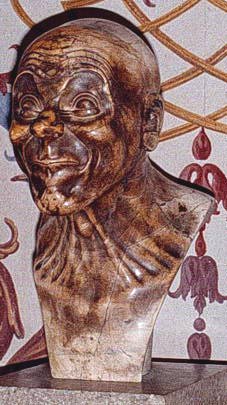The Simpleton (Messerschmidt)
The Simpleton is a notable sculpture created by the 18th-century Austrian artist Franz Xaver Messerschmidt. Messerschmidt, born in 1736 in Wiesensteig, was a prominent figure in the European art scene, particularly known for his character heads, a series of busts that depicted various facial expressions and emotional states. "The Simpleton" is part of this series, which has intrigued art historians and psychologists alike for its exploration of human expressions and emotions.
Description[edit | edit source]
"The Simpleton" is a bust that captures a peculiar facial expression, which has been interpreted as a naive or foolish grin. The sculpture is meticulously crafted, showcasing Messerschmidt's skill in rendering detailed facial features. The work is made of alabaster, a material chosen for its smoothness and ability to reflect light, enhancing the lifelike quality of the sculpture. The subject's eyes are wide open, and the mouth is slightly agape, contributing to the overall impression of innocence or simplicity.
Context and Interpretation[edit | edit source]
Messerschmidt's character heads, including "The Simpleton," were created during a period of the artist's life marked by personal turmoil and professional challenges. After losing his position at the Academy of Fine Arts Vienna, Messerschmidt retreated to Pressburg (now Bratislava), where he devoted himself to this unconventional project. The character heads are often seen as a reflection of the artist's psychological state, as well as a radical departure from the neoclassical norms of his time.
"The Simpleton" and its counterparts challenge traditional representations of beauty and emotion in art, offering instead a raw and unidealized exploration of human psychology. Some scholars suggest that these works were influenced by Messerschmidt's own experiences with mental illness, which might have heightened his interest in the more extreme expressions of the human face.
Legacy[edit | edit source]
Today, "The Simpleton" is considered a significant work in the oeuvre of Franz Xaver Messerschmidt. It exemplifies the artist's innovative approach to portraiture and his contribution to the study of facial expressions. The sculpture, along with other character heads, has been the subject of numerous exhibitions and studies, highlighting its enduring appeal and relevance in the fields of art history and psychology.
Search WikiMD
Ad.Tired of being Overweight? Try W8MD's physician weight loss program.
Semaglutide (Ozempic / Wegovy and Tirzepatide (Mounjaro / Zepbound) available.
Advertise on WikiMD
|
WikiMD's Wellness Encyclopedia |
| Let Food Be Thy Medicine Medicine Thy Food - Hippocrates |
Translate this page: - East Asian
中文,
日本,
한국어,
South Asian
हिन्दी,
தமிழ்,
తెలుగు,
Urdu,
ಕನ್ನಡ,
Southeast Asian
Indonesian,
Vietnamese,
Thai,
မြန်မာဘာသာ,
বাংলা
European
español,
Deutsch,
français,
Greek,
português do Brasil,
polski,
română,
русский,
Nederlands,
norsk,
svenska,
suomi,
Italian
Middle Eastern & African
عربى,
Turkish,
Persian,
Hebrew,
Afrikaans,
isiZulu,
Kiswahili,
Other
Bulgarian,
Hungarian,
Czech,
Swedish,
മലയാളം,
मराठी,
ਪੰਜਾਬੀ,
ગુજરાતી,
Portuguese,
Ukrainian
Medical Disclaimer: WikiMD is not a substitute for professional medical advice. The information on WikiMD is provided as an information resource only, may be incorrect, outdated or misleading, and is not to be used or relied on for any diagnostic or treatment purposes. Please consult your health care provider before making any healthcare decisions or for guidance about a specific medical condition. WikiMD expressly disclaims responsibility, and shall have no liability, for any damages, loss, injury, or liability whatsoever suffered as a result of your reliance on the information contained in this site. By visiting this site you agree to the foregoing terms and conditions, which may from time to time be changed or supplemented by WikiMD. If you do not agree to the foregoing terms and conditions, you should not enter or use this site. See full disclaimer.
Credits:Most images are courtesy of Wikimedia commons, and templates Wikipedia, licensed under CC BY SA or similar.
Contributors: Prab R. Tumpati, MD

